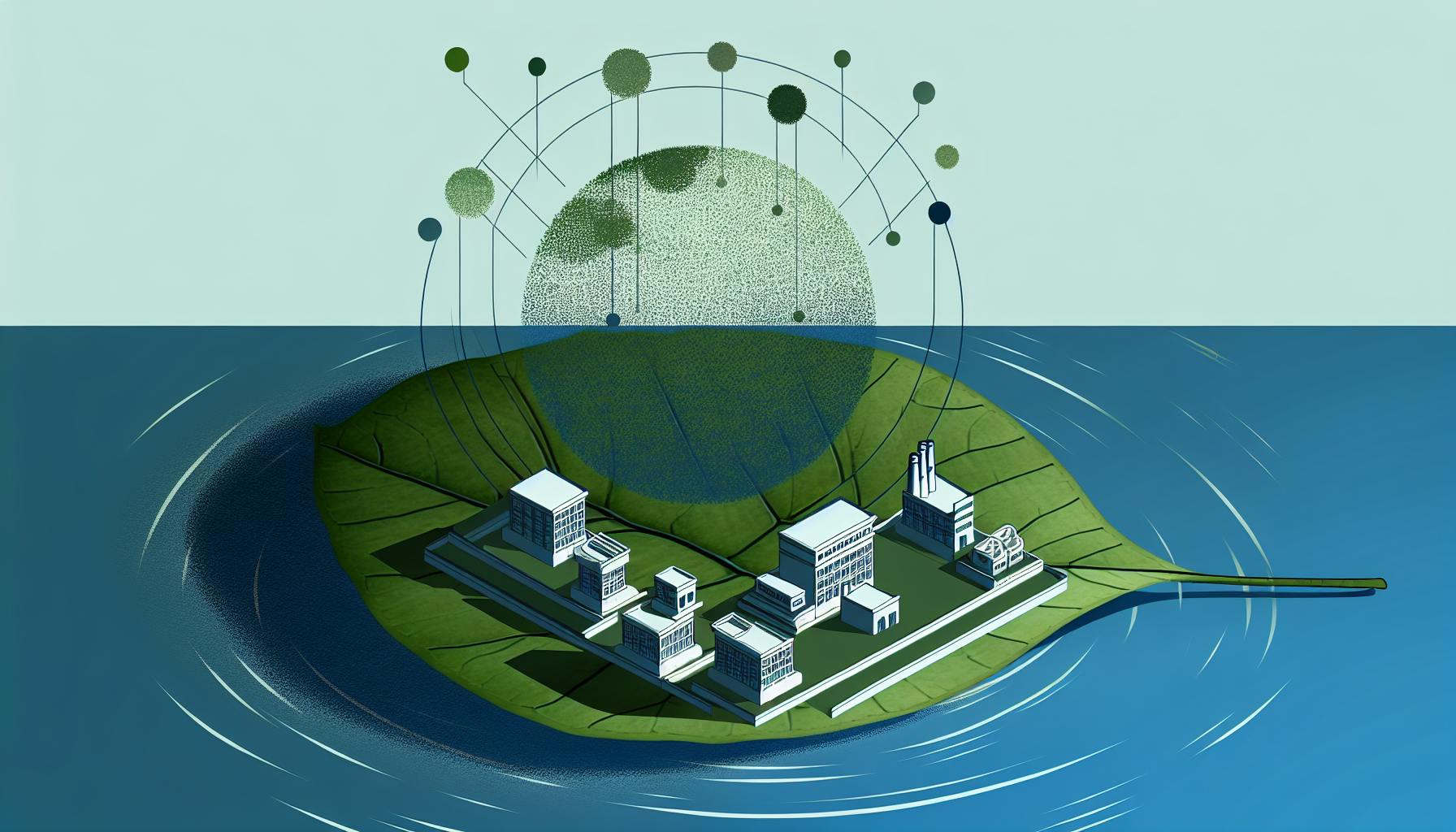We can all agree that climate change is an urgent issue, and businesses have an important role to play in reducing emissions.
By understanding their carbon footprint, small and medium-sized enterprises (SMEs) can take strategic steps to minimize their climate impact while boosting efficiency and strengthening their brand.
In this article, we will demystify the carbon footprint concept for SMEs, explore its sources and measurement approaches, and outline practical strategies to shrink their footprint while future-proofing operations.
Unpacking the Carbon Footprint for SMEs
A carbon footprint refers to the total greenhouse gas (GHG) emissions caused directly and indirectly by an individual, organization, event or product. For businesses, this includes emissions from operations, supply chains, transportation, energy use and more. Understanding carbon footprints is becoming increasingly important for small and medium-sized enterprises (SMEs) to manage environmental impacts and prepare for emerging regulations.
Decoding the Carbon Footprint Concept
At its core, a carbon footprint measures the total climate impact of an entity based on how much carbon dioxide (CO2) and other GHGs are emitted. While often simplified as CO2 equivalents for measurement purposes, it encompasses all major GHGs like methane and nitrous oxide associated with operations.
For SMEs specifically, key sources of emissions usually include:
- Facilities energy usage
- Business travel and transportation
- Supply chain activities
- Waste disposal
By quantifying emissions across these areas using available calculation tools and global reporting standards, SMEs can understand their carbon footprint as a baseline for reduction strategies.
Relevance of Carbon Management in Today's Business World
With sustainability becoming mainstream and mandatory emissions reporting looming in many regions, measuring and lowering carbon footprints is a rising operational priority for SMEs worldwide.
Major reasons it now crucial include:
- Complying with current and upcoming regulations
- Accessing environmental impact data demanded by investors
- Meeting customer expectations for sustainable practices
- Boosting brand image and competitive positioning around climate action
Early movers can gain financial and reputational advantages over delaying peers.
Strategic Advantages for SMEs Reducing Their Carbon Footprint
Beyond external pressures, curbing emissions can also directly benefit SMEs through:
Cost Savings
- Greater energy efficiencies
- Reduced transportation expenses
- Tax incentives for green investments
Resilience
- Future-proofing against tighter regulations
- Shielding from fossil fuel price volatility
Competitive Edge
- Positive ESG profile to help attract investors
- Preferred supplier status for major corporate clients
Overall, evaluating and minimizing their carbon footprint now allows SMEs to operate responsibly while unlocking strategic opportunities. The next section explores available methods.
What does carbon footprint mean?
A carbon footprint refers to the total greenhouse gas emissions caused directly and indirectly by an individual, organization, event or product. It is measured in tons of carbon dioxide equivalent.
Some key things to know about carbon footprints:
- A carbon footprint considers all six greenhouse gases covered under the Kyoto Protocol - carbon dioxide, methane, nitrous oxide, hydrofluorocarbons, perfluorocarbons and sulfur hexafluoride. However, it is expressed in terms of carbon dioxide equivalent (CO2e) based on the global warming potential of each gas.
- It includes both direct emissions from owned or controlled sources like facilities and vehicles, as well indirect emissions from the upstream supply chain or downstream product use.
- For businesses, the major sources of emissions are typically from energy use in operations, transportation, distribution and business travel. Other factors also play a role based on the specific industry.
- There are a few common carbon footprint calculators like the Greenhouse Gas Protocol that help estimate emissions using primary data on energy, materials, waste etc. More complex life cycle assessments can also be performed.
- The size of a carbon footprint can depend on the boundaries chosen for assessment. A narrower boundary focused only on operations is simpler but risks missing out on larger indirect impacts.
Understanding their organization's carbon footprint is an important first step for SMEs seeking to reduce emissions. It establishes a baseline to track progress, identify hotspots, and make strategic investments towards sustainability goals.
What are some examples of carbon footprint?
Our daily activities like driving vehicles, heating our homes, and using electricity contribute to greenhouse gas emissions that make up our carbon footprint.
Here are a few common examples of carbon footprint sources:
- Transportation - Burning gasoline in vehicles produces greenhouse gases like carbon dioxide and methane. Activities like commuting by car and air travel contribute to your transportation emissions footprint.
- Home Energy Use - Burning natural gas, oil, or using electricity from fossil fuel power plants releases emissions that contribute to your household's carbon footprint. Using energy for appliances, lighting, heating and cooling homes produces greenhouse gases.
- Food Production - Agriculture and food production generates significant greenhouse gas emissions from activities like deforestation for crops, livestock digestion processes, transportation of food products, and more. The foods we eat contribute to our carbon footprint.
- Waste Disposal - As waste breaks down in landfills, methane is released into the atmosphere adding to our carbon footprint. Other disposal methods like incineration also cause emissions. Recycling and reducing waste can lower emissions related to waste.
In summary, carbon footprint refers to the total emissions caused by our everyday actions and consumption. Knowing the main sources like transportation, household energy, food, and waste disposal can help us understand and reduce our individual carbon footprints.
What does it mean when you have a high carbon footprint?
A carbon footprint is a measure of the greenhouse gas emissions caused directly and indirectly by an individual, organization, event, product or service. A high carbon footprint means your activities are resulting in substantial amounts of greenhouse gas emissions that contribute to climate change.
Some key things to know about having a high carbon footprint:
- It puts greater strain on the environment and exacerbates climate change. The higher the emissions caused by your actions, the more you are contributing to rising global temperatures, melting ice caps, extreme weather events and other climate impacts.
- It can undermine sustainability efforts and make it harder to achieve emission reduction goals. Organizations with large carbon footprints will have to work much harder to reach net zero emissions compared to peers with smaller footprints.
- It has reputational risks. Companies with high carbon footprints may face greater scrutiny from regulators, investors, customers and the public. They need to be prepared to demonstrate how they are measuring, reporting and reducing emissions.
- It highlights opportunities to lower emissions through changes in operations, energy sources, materials, transportation or other activities. For many organizations, shrinking their carbon footprint can also reduce costs and improve efficiency.
While every individual and business has some level of carbon footprint, those with exceptionally large ones have an obligation and commercial incentive to implement comprehensive emission reduction strategies. Understanding the size of your footprint is the critical first step to lowering it.
What should my carbon footprint be?
The ideal carbon footprint for most individuals and businesses typically ranges between 6,000 to 15,999 pounds of carbon dioxide emissions per year. This is considered a low to moderate level of emissions that reflects environmentally-conscious actions and sustainability efforts.
Here is a quick guide to carbon footprint ranges:
- Under 6,000 pounds - Very low carbon footprint demonstrating exceptional commitment to emissions reduction activities
- 6,000 - 15,999 pounds - Low carbon footprint showing solid climate action through everyday lifestyle and business choices
- 16,000 - 22,000 pounds – Average carbon footprint aligned with common emissions behaviors and operations
- Over 22,000 pounds - High carbon footprint signaling opportunities to assess and improve sustainability initiatives
To determine your target carbon footprint goal, consider your company's size, industry, logistics, supply chain, facilities, fleet, business travel, and other factors dictating your overall emissions profile. Assess your capabilities realistically to pursue carbon neutrality over time through technological innovations, operational efficiencies, renewable energy, carbon offsets, and stakeholder engagement.
Monitor your carbon footprint annually using accurate tracking and reporting tools. This allows you to evaluate progress in lowering your climate impact and maintaining transparency with important audiences like leadership, investors, partners, customers, and employees. Consistent measurement and verification also helps ensure environmental compliance and eligibility for sustainability certifications.
With a practical approach, reasonable timeline, and commitment to continual improvement, your company can achieve an optimum carbon footprint demonstrating climate leadership.
sbb-itb-0f1f828
Types and Sources of Carbon Footprint in SMEs
SMEs generate carbon emissions from various direct and indirect sources related to their business operations. Understanding these emission sources is key for SMEs to measure, report on, and reduce their carbon footprint.
Direct vs. Indirect Carbon Footprint
- Direct (Scope 1) emissions come from sources owned or controlled by the company. This includes emissions from fuel combustion, company vehicles, and fugitive refrigerants.
-
Indirect emissions fall under Scope 2 and Scope 3:
- Scope 2 covers emissions from purchased electricity used in company buildings and operations.
- Scope 3 emissions occur from value chain activities not owned or controlled by the company. These indirect emissions often form the majority of an SME's carbon footprint.
Identifying SMEs' Carbon Hotspots
Typical carbon hotspots for SMEs include:
- Office energy usage - Heating, cooling, lighting, IT equipment
- Transportation - Fleet vehicles, employee commuting and business travel
- Supply chain - Emissions from sourcing materials, shipping, and waste disposal
Prioritizing these hotspots can have the greatest emissions reduction impact.
Influence of Business Size and Sector on Carbon Emissions
An SME's carbon footprint varies substantially based on factors like:
- Industry - Transport and manufacturing SMEs have higher footprint than professional services
- Office size - More employees commuting and using office facilities
- Operations - More equipment, facilities and logistics increase footprint
Understanding these variables allows SMEs to benchmark emissions specific to their business profile.
How Is a Carbon Footprint Calculated for SMEs?
This section provides an overview of the methodologies used to quantify an SME's carbon emissions and introduces a simple carbon footprint calculator for initial assessments.
Approaches to Carbon Footprint Measurement
There are a few common approaches SMEs can use to calculate their carbon footprint what does it mean:
- Simple carbon calculators: These easy-to-use online tools allow you to input basic data about your company's operations to generate a rough emissions estimate. While not extremely precise, they offer a quick way to get a general sense of your carbon impact.
- Greenhouse Gas Protocol: This is an internationally recognized standard for quantifying and reporting GHG emissions. It provides guidelines on setting organizational and operational boundaries, choosing emissions factors, and collecting accurate activity data across Scopes 1, 2, and 3 to calculate your footprint.
- Life cycle assessments: LCAs take a comprehensive, cradle-to-grave view of a product or service's emissions across its entire lifecycle. Though more complex, this methodology provides in-depth understanding of total climate impact.
Leveraging a Simple Carbon Footprint Calculator
Simple online carbon calculators only require basic inputs like office size, number of employees, transportation modes, and energy sources to generate an initial footprint estimate. Though not completely precise, they provide an easy way for SMEs to grasp their general carbon impact and identify hotspots for reduction. Regular use can reveal emission trends over time.
The Importance of Accurate Emissions Data Collection
While simple calculators offer rough estimates, accurate carbon accounting requires rigorous data collection on all organizational activities according to GHG Protocol guidelines. Precise emissions factors must also be chosen based on energy sources. Higher data quality enables smaller companies to set effective reduction targets and track performance against sustainability goals. Evaluating data procedures is key to reliable footprint analysis.
Strategies for Reducing SMEs' Carbon Footprint
Reducing carbon emissions can seem daunting for small and medium-sized enterprises (SMEs), but taking small, incremental steps to improve energy efficiency and incorporate renewables can add up to make a real impact. Here are some practical ideas to get you started:
Energy Efficiency: Quick Wins for SMEs
Implementing energy efficiency measures is one of the most effective ways for SMEs to reduce overhead costs and carbon footprint. Simple upgrades to switch to LED lighting, improve insulation, and install smart thermostats can generate 20-30% energy savings with minimal upfront costs.
Additional no-cost and low-cost tactics like ensuring regular HVAC maintenance, eliminating phantom load from electronics, and encouraging employees to switch off devices can also lead to modest reductions. Consider an energy audit to identify major problem areas suited for efficiency upgrades.
Transitioning to Renewable Energy Solutions
While installing full-scale solar systems may be capital-intensive, SMEs can opt for solar leases or pursue community solar programs for accessing renewable energy at lower costs. Procuring certified renewable energy credits (RECs) through your utility is another route to cost-effectively reduce some portion of your electricity emissions.
For SMEs with large vehicle fleets, switching to electric or hybrid models can also substantially cut emissions and fuel costs over time. Explore federal and local incentives that can offset the higher upfront price tag of these vehicles.
The Role of Offsetting in Carbon Reduction Plans
Carbon offsetting allows companies to balance out their residual emissions by funding external emission reduction projects. Offsets enable SMEs to fully neutralize their carbon footprint while working on reducing internal emissions.
However, offsets should complement rather than replace internal carbon reduction initiatives. Prioritize energy efficiency upgrades and renewable energy procurement first before looking into reputable offsetting programs certified to global standards.
Communicating Your SME's Carbon Footprint Journey
SMEs can promote trust and transparency around their sustainability efforts by clearly communicating their carbon footprint and reduction strategies. Best practices in sustainability reporting, third-party certifications, and compelling storytelling can demonstrate an SME's commitment to addressing climate change.
Best Practices in Sustainability Reporting
Integrating carbon accounting into standard business reporting allows SMEs to systematically track and disclose emissions data. Widely adopted frameworks like the Greenhouse Gas Protocol provide clear guidance for calculating and classifying emissions sources using digital tools. Adopting consistent global standards lends credibility even for SMEs at early stages of the net zero journey. Consider consulting sustainability experts when preparing your first reports.
Using Certifications to Validate Green Initiatives
Independent sustainability certifications like B Corp can validate that your business meets rigorous standards of social and environmental accountability. Display certifications prominently across company assets to signal your commitment to stakeholders. Seek out certifications that align with your sector and business model. Understand that pursuing strict standards may require changes to internal processes and supplier relationships.
Storytelling: Sharing Your Green Journey with Customers
Leverage sustainability reports to craft compelling stories about your business's evolving carbon reduction journey. Put data-driven facts into context by explaining how specific operational changes impacted footprint metrics quarter to quarter. Feature green employee and supplier champions who catalyzed shifts towards more sustainable practices. Maintain radical transparency around challenges encountered to demonstrate authenticity to increasingly climate-conscious consumers.
Conclusion: Embracing a Low-Carbon Future for SMEs
Synthesizing the Carbon Footprint Path for SMEs
Understanding your company's carbon footprint is an important first step for SMEs looking to reduce their environmental impact. By calculating emissions across scopes 1, 2, and 3, businesses can identify their largest sources of emissions and prioritize reduction strategies. As regulatory requirements grow and stakeholders demand increased transparency, the ability to accurately measure and report emissions will only become more critical.
Tools like the EcoHedge software can remove major barriers to carbon accounting, making the process simple, automated, and integrated. The insights generated allow SMEs to set informed emission reduction targets, select appropriate decarbonization projects, and communicate progress to key stakeholders. Whether just starting the sustainability journey or seeking to reach ambitious goals like net-zero, the right carbon accounting system provides the foundation.
Overall, embracing carbon footprint management positions SMEs for resiliency and growth in a low-carbon future. It not only mitigates regulatory and reputational risks, but can reveal operational efficiencies, open new market opportunities, and demonstrate leadership. The environmental and economic benefits make building a comprehensive carbon strategy a strategic priority for forward-looking companies.
Final Reflections on Carbon Stewardship for SMEs
Ultimately, SMEs have a crucial role to play in driving large-scale emissions reductions across the private sector. By taking responsibility over their own footprints, they set an example and pressure larger companies to follow suit. As stakeholders and governments ramp up calls for urgent, far-reaching climate action over this decisive decade, the leadership of SMEs will be critical.
While the process can seem daunting initially, the right carbon accounting tools and expertise can simplify the transition in tangible, cost-effective ways. Rather than a burden, proactive environmental stewardship fueled by data-driven insights will soon be a vital pillar of a thriving, future-oriented SME. The time for climate awareness is now and carbon provides the key metric to guide the sustainability journey.



